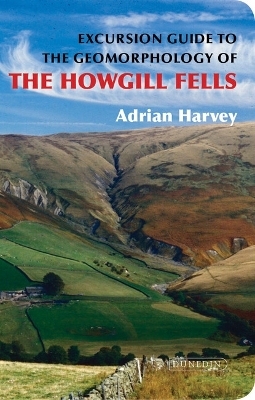
Excursion Guide to the Geomorphology of the Howgill Fells
Seiten
2017
Liverpool University Press (Verlag)
978-1-78046-070-3 (ISBN)
Liverpool University Press (Verlag)
978-1-78046-070-3 (ISBN)
The Howgills form part of the Yorkshire Dales National Park. The fells are an important study area, especially in relation to modern process geomorphology but also in the context of environmental change. The purpose of this field guide is to give background for students of geomorphology and late Quaternary environmental change.
The Howgill Fells in Cumbria, represent one of the most erosionally active landscapes in Britain. The bedrock geology, folded Silurian mudstones, is not especially well seen. The direct effects of Pleistocene glaciation are limited and not as well developed as in the neighbouring Lake District, although glacial meltwaters did have an important impact. However, it is in its post-glacial landscape that the Howgills are exceptional. The steep hillslopes of the headwater valleys are riddled by networks of erosional gullies, many active during the last few thousand years but now stabilised, others actively erosional now. The gully systems feed sediment downslope, locally forming large tributary-junction alluvial fans, elsewhere creating braided reaches within the stream channels.The Holocene sequence of hillslope gully erosion, alluvial fan deposition, and stream terrace aggradation and dissection is exceptionally well exhibited by numerous exposed sections through the sedimentary sequences. The modern active gully systems have been monitored for more than thirty years. The results of this long-term study illustrate two fundamental aspects of process geomorphology: first, the importance of coupling, i.e. linkages, within the geomorphic system, and secondly, the significance of magnitude/frequency relationships. Essentially, the Howgills form an excellent field laboratory for the study of modern processes and landforms as well as retaining the evidence for reconstructing the erosion/deposition sequence of the last few thousand years.The book is organised in two sections. A series of thematic chapters is followed by chapters dealing with details of recommended field excursions. The first excursion is a car-based excursion around the margins of the Howgills but the other excursions are all hiking excursions into the interior of the Howgills. One of the joys of the interior of the Howgills is that they form an upland block, within which there is no settlement, there are no roads and virtually no walls. You have to hike in to see, study and learn!The book is copiously illustrated by maps, diagrams and colour photographs.
The Howgill Fells in Cumbria, represent one of the most erosionally active landscapes in Britain. The bedrock geology, folded Silurian mudstones, is not especially well seen. The direct effects of Pleistocene glaciation are limited and not as well developed as in the neighbouring Lake District, although glacial meltwaters did have an important impact. However, it is in its post-glacial landscape that the Howgills are exceptional. The steep hillslopes of the headwater valleys are riddled by networks of erosional gullies, many active during the last few thousand years but now stabilised, others actively erosional now. The gully systems feed sediment downslope, locally forming large tributary-junction alluvial fans, elsewhere creating braided reaches within the stream channels.The Holocene sequence of hillslope gully erosion, alluvial fan deposition, and stream terrace aggradation and dissection is exceptionally well exhibited by numerous exposed sections through the sedimentary sequences. The modern active gully systems have been monitored for more than thirty years. The results of this long-term study illustrate two fundamental aspects of process geomorphology: first, the importance of coupling, i.e. linkages, within the geomorphic system, and secondly, the significance of magnitude/frequency relationships. Essentially, the Howgills form an excellent field laboratory for the study of modern processes and landforms as well as retaining the evidence for reconstructing the erosion/deposition sequence of the last few thousand years.The book is organised in two sections. A series of thematic chapters is followed by chapters dealing with details of recommended field excursions. The first excursion is a car-based excursion around the margins of the Howgills but the other excursions are all hiking excursions into the interior of the Howgills. One of the joys of the interior of the Howgills is that they form an upland block, within which there is no settlement, there are no roads and virtually no walls. You have to hike in to see, study and learn!The book is copiously illustrated by maps, diagrams and colour photographs.
Adrian Harvey is a retired Professor of Geomorphology from the University of Liverpool. He has published many research papers on Howgill geomorphic processes, and, often with colleagues, on the Holocene landform sequence. He has led field trips to the area for more than forty years.
Acknowledgements. First Part – The Geomorphology of the Howgill Fells: 1: Introduction Regional overview; 2: Holocene Landform evolution; 3: The modern geomorphic system. Second Part – The field sites: Chapter 5: A Reconnaissance road trip around the Howgill Fells; 6: The Western Howgills. 7: The Northern Howgills. 8: The Southern Howgills. 8: Final Reflections. References. Appendices
| Erscheinungsdatum | 01.07.2017 |
|---|---|
| Verlagsort | Liverpool |
| Sprache | englisch |
| Maße | 133 x 230 mm |
| Gewicht | 248 g |
| Themenwelt | Naturwissenschaften ► Biologie ► Ökologie / Naturschutz |
| Naturwissenschaften ► Geowissenschaften ► Geografie / Kartografie | |
| Naturwissenschaften ► Geowissenschaften ► Geologie | |
| ISBN-10 | 1-78046-070-8 / 1780460708 |
| ISBN-13 | 978-1-78046-070-3 / 9781780460703 |
| Zustand | Neuware |
| Haben Sie eine Frage zum Produkt? |
Mehr entdecken
aus dem Bereich
aus dem Bereich


